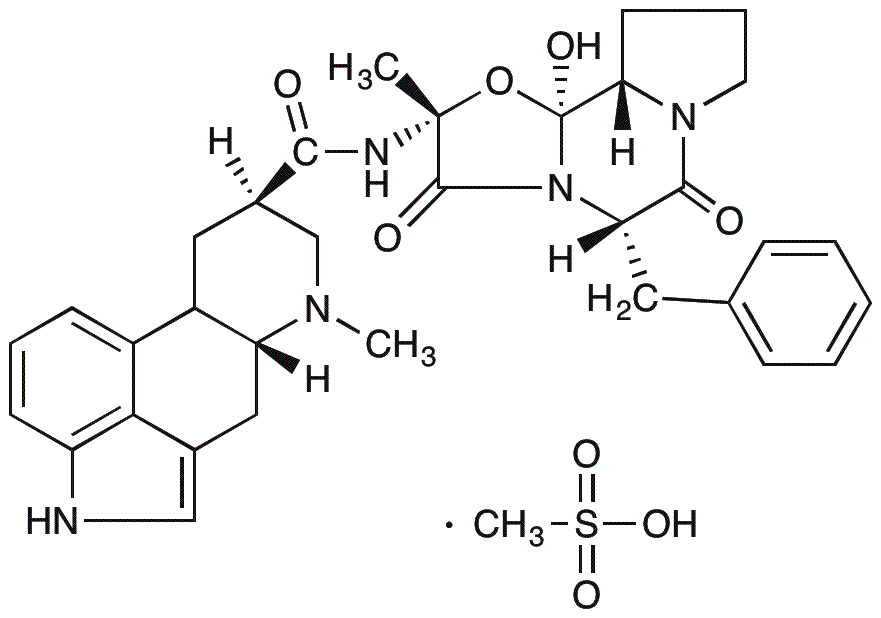Dihydroergotamine methanesulfonate salt is widely utilized in research focused on:
- Migraine Treatment: This compound is primarily used in the medical field to treat acute migraine attacks. It works by constricting blood vessels in the brain, providing relief to patients who suffer from severe headaches.
- Vascular Research: In pharmacological studies, it serves as a model compound for understanding vascular responses. Researchers can explore its effects on blood flow and vascular tone, aiding in the development of new cardiovascular therapies.
- Pharmaceutical Development: The compound is often used in the formulation of medications, allowing scientists to study its stability and efficacy in various delivery systems, such as intranasal or injectable forms.
- Neuropharmacology: It is utilized in neuropharmacological research to investigate its interactions with serotonin receptors, contributing to the understanding of neurotransmitter systems and potential treatments for other neurological disorders.
- Clinical Trials: Dihydroergotamine methanesulfonate salt is frequently involved in clinical trials aimed at assessing new therapeutic strategies for migraine and other headache disorders, providing valuable data for future drug approvals.
General Information
Properties
Safety and Regulations
Applications
Dihydroergotamine methanesulfonate salt is widely utilized in research focused on:
- Migraine Treatment: This compound is primarily used in the medical field to treat acute migraine attacks. It works by constricting blood vessels in the brain, providing relief to patients who suffer from severe headaches.
- Vascular Research: In pharmacological studies, it serves as a model compound for understanding vascular responses. Researchers can explore its effects on blood flow and vascular tone, aiding in the development of new cardiovascular therapies.
- Pharmaceutical Development: The compound is often used in the formulation of medications, allowing scientists to study its stability and efficacy in various delivery systems, such as intranasal or injectable forms.
- Neuropharmacology: It is utilized in neuropharmacological research to investigate its interactions with serotonin receptors, contributing to the understanding of neurotransmitter systems and potential treatments for other neurological disorders.
- Clinical Trials: Dihydroergotamine methanesulfonate salt is frequently involved in clinical trials aimed at assessing new therapeutic strategies for migraine and other headache disorders, providing valuable data for future drug approvals.
Documents
Safety Data Sheets (SDS)
The SDS provides comprehensive safety information on handling, storage, and disposal of the product.
Product Specification (PS)
The PS provides a comprehensive breakdown of the product’s properties, including chemical composition, physical state, purity, and storage requirements. It also details acceptable quality ranges and the product's intended applications.
Certificates of Analysis (COA)
Search for Certificates of Analysis (COA) by entering the products Lot Number. Lot and Batch Numbers can be found on a product’s label following the words ‘Lot’ or ‘Batch’.
*Catalog Number
*Lot Number
Certificates Of Origin (COO)
This COO confirms the country where the product was manufactured, and also details the materials and components used in it and whether it is derived from natural, synthetic, or other specific sources. This certificate may be required for customs, trade, and regulatory compliance.
*Catalog Number
*Lot Number
Safety Data Sheets (SDS)
The SDS provides comprehensive safety information on handling, storage, and disposal of the product.
DownloadProduct Specification (PS)
The PS provides a comprehensive breakdown of the product’s properties, including chemical composition, physical state, purity, and storage requirements. It also details acceptable quality ranges and the product's intended applications.
DownloadCertificates of Analysis (COA)
Search for Certificates of Analysis (COA) by entering the products Lot Number. Lot and Batch Numbers can be found on a product’s label following the words ‘Lot’ or ‘Batch’.
*Catalog Number
*Lot Number
Certificates Of Origin (COO)
This COO confirms the country where the product was manufactured, and also details the materials and components used in it and whether it is derived from natural, synthetic, or other specific sources. This certificate may be required for customs, trade, and regulatory compliance.


